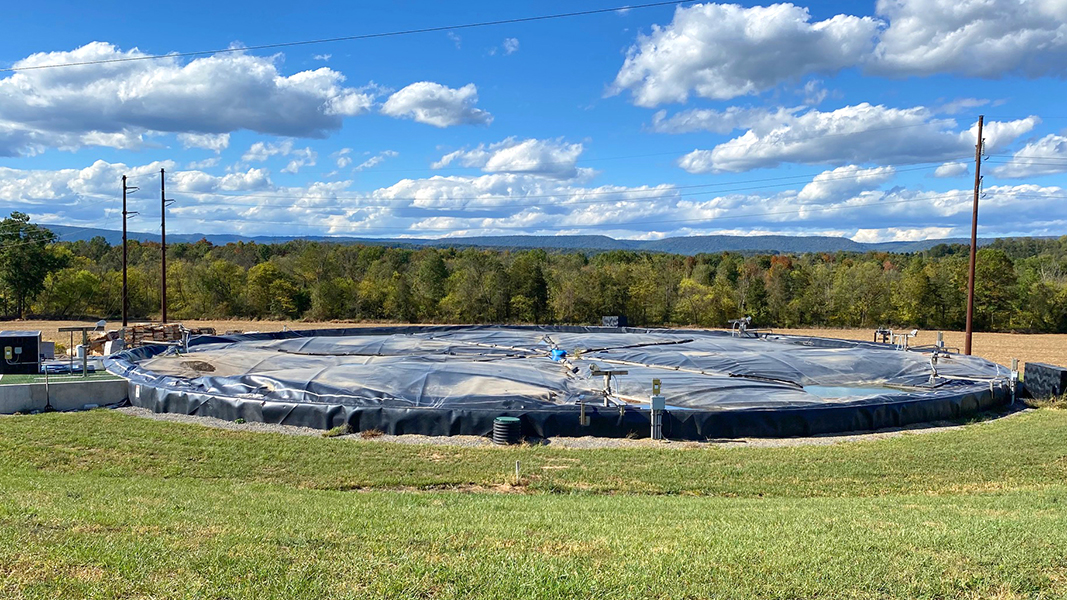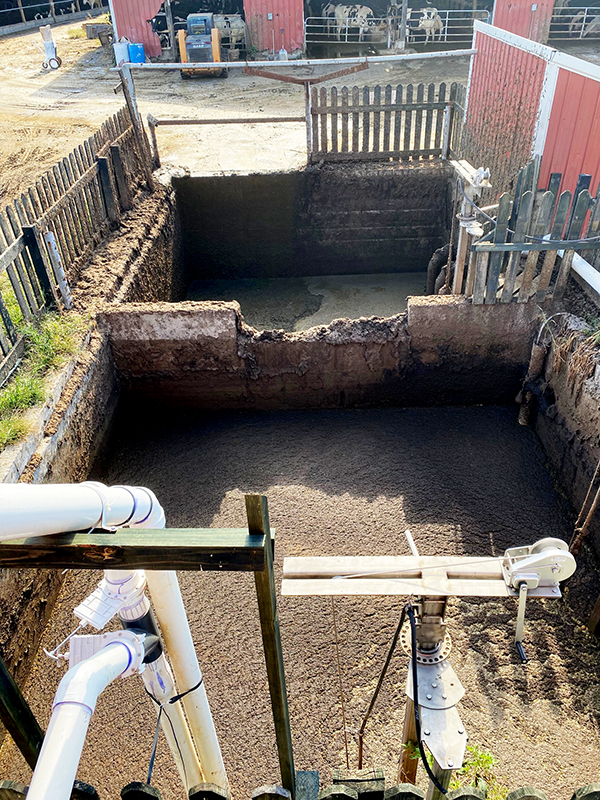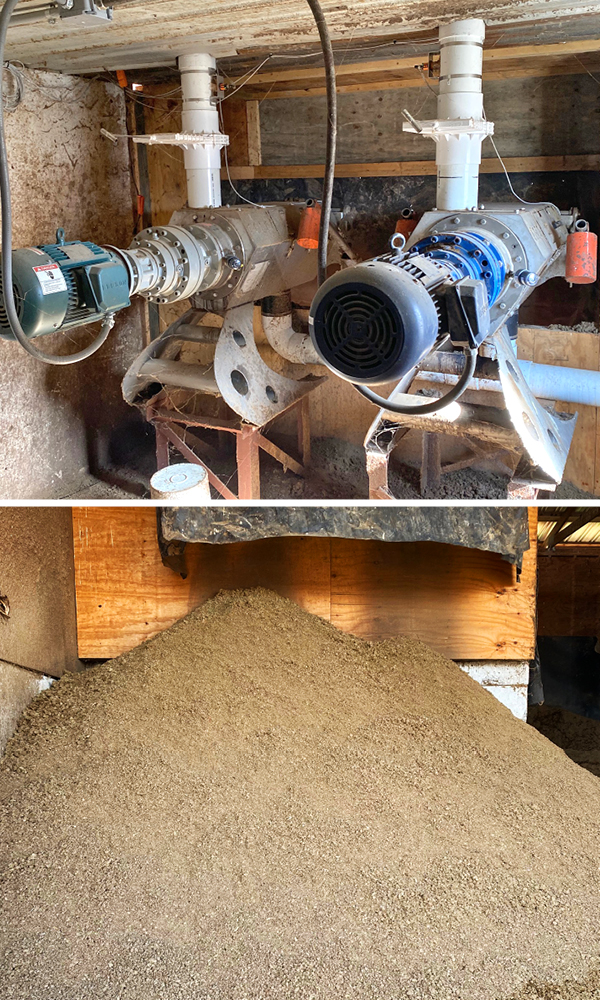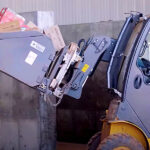Top: The second digester at Reinford Farms, about 3 times the size of the first, began operating in late 2019.
Nora Goldstein
 Reinford Farms is located in Mifflintown in central Pennsylvania. Steve and Gina Reinford purchased the farm in 1991, starting out with 57 dairy cows and 144 acres. Their 3 sons — Chad, Brett and Drew — are all involved in the family business. In 2008, Reinford Farms installed a 526,000-gallon complete-mix anaerobic digester supplied by RCM (now known as Martin Construction Resources (MCR)), sized to treat manure from 800 dairy cows. There were about 400 cows at the time. Capital costs for the digester and related equipment were about $1.1 million. Federal and state grants and/or tax credits covered about half of the cost.
Reinford Farms is located in Mifflintown in central Pennsylvania. Steve and Gina Reinford purchased the farm in 1991, starting out with 57 dairy cows and 144 acres. Their 3 sons — Chad, Brett and Drew — are all involved in the family business. In 2008, Reinford Farms installed a 526,000-gallon complete-mix anaerobic digester supplied by RCM (now known as Martin Construction Resources (MCR)), sized to treat manure from 800 dairy cows. There were about 400 cows at the time. Capital costs for the digester and related equipment were about $1.1 million. Federal and state grants and/or tax credits covered about half of the cost.
“We built it with the plan that we would grow into that digester in terms of cow numbers,” recalls Brett Reinford, whom we interviewed in September for this article. “It was not sized to take food waste. But as soon as the digester was built, we received a call asking if we could take food waste. We said yes, and within a year, we had maxed out the digester’s capacity. Some biogas had to be flared because the engine motor was at full capacity.”
The food waste — mostly produce from Sam’s Clubs and Walmart stores in the region — was emptied into a holding pit and then loaded into a grinder. “My dad took a forage chopper and revamped it to suit our needs,” Reinford said in a 2011 BioCycle article. “The food waste was ground for 30 to 45 minutes and then added to a concrete gravity-fed influent tank where it was mixed with manure.”
He adds that the digester was run at or sometimes over capacity (by reducing retention time in the digester) for about 5 years. As Reinford Farms started to pick up more food waste clients, it began exploring the option of adding a second digester. “We wanted to be confident we had the food waste flow before we made the investment,” says Reinford. “In 2015, we embarked on raising the funds necessary to install a second system. There was a federal tax credit for 30% of the value of the digester, but we needed a partner who could take the tax credit, and then pay Reinford Farms. Two weeks before we were going to close the deal, our partner backed out. At that point, we had a state grant for about 30% of the cost and a Natural Resources Conservation Service grant for $400,000. We had until 2019 to use those grants before they expired and finally were able to get funding via a different tax credit program to pull it off.”
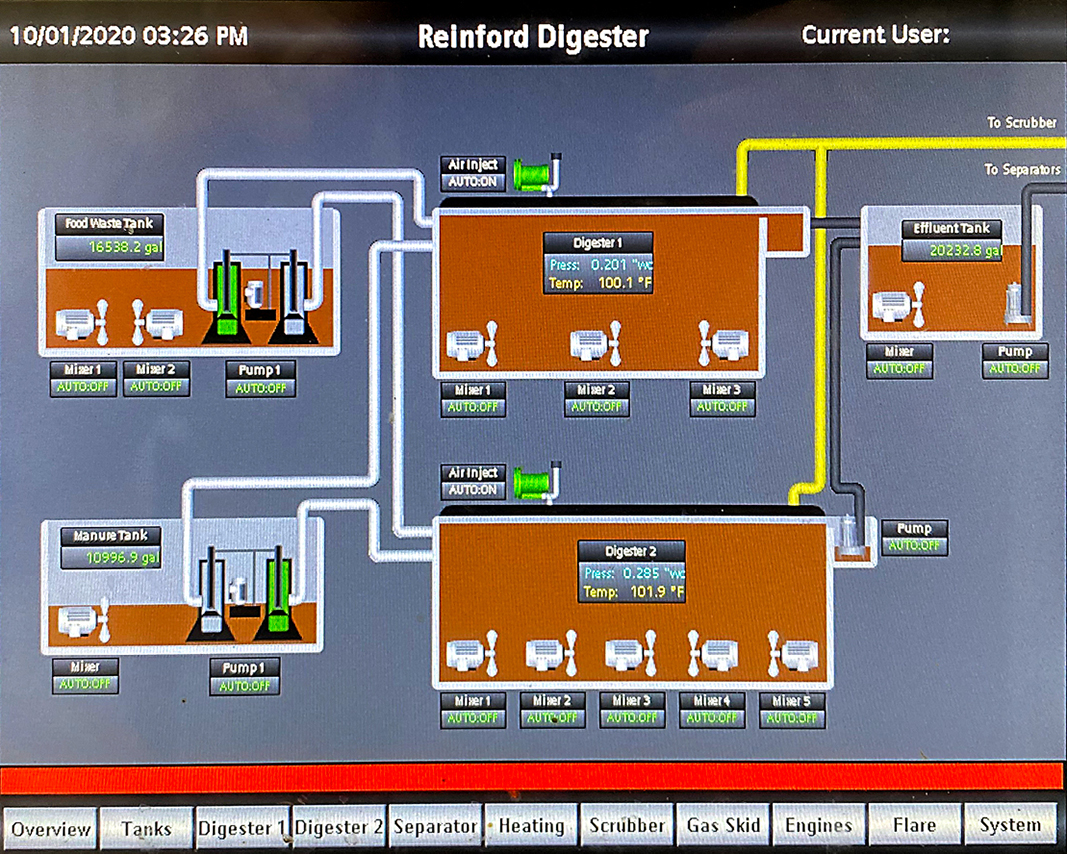
Digester control panel shows the food waste tank (top left) and the manure influent tank (bottom left) that feed material into the 2 digesters (center of screen). The effluent tank is shown in upper right.
The second digester — also purchased from MCR — began operating at the end of 2019. It is about 3 times the size of the first (1.5 million gallons). Earlier in 2019, the original digester caught fire, blowing its top off. “It was an old-style design with the mixer motors mounted on the cover,” explains Reinford. “There was methane escaping from the cover. Sparks from the motor ignited the methane. The motors for the mixers are now submersed in the manure of the original digester — as well as the new digester.”
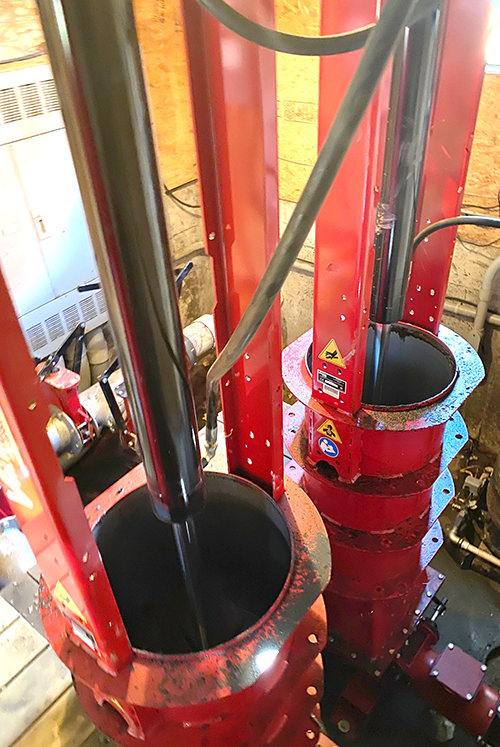
Piston pumps are installed next to both the manure influent tank and the food waste tank to pump those materials into the 2 digesters.
Several other modifications were made when building the new digester. A 50,000-gallon tank to hold food waste was installed to better control the amount being added to each digester. “We had no way to balance that previously when the food waste was being mixed with the manure in the influent tank,” he adds. “We also installed new mixers and pumps that are more equipped to deal with the thickness of the food waste in the digester. When the cover came off our original digester, we saw about 50% solids, when it should have been more in the 10% to 12% range. We believe some of the grains and minerals that we were feeding the cows settled to the bottom. We were not able to suspend the sand-like grit that was found because we did not have reliable mixers.”
Food Waste Processing
The Pennsylvania Department of Environmental Protection (PADEP) has a General Permit (WMGM042) that authorizes anaerobic digestion of animal manure on a farm mixed with grease trap waste (collected from restaurants or grocery stores) and preconsumer and postconsumer food waste from commercial or institutional establishments. Both of Reinford Farms’ digesters have that general permit, which does not set a limit on how much food waste a farm can accept. However, the farm’s water quality permit sets a threshold of up to 50% food waste codigested with manure. “With our 800 cows, we are still under the 50% threshold,” says Reinford.
Combined, the digesters have capacity to codigest 25,000 tons/year of food waste; Reinford Farms currently processes about 10,000 to 12,000 tons/year (about 250 tons/week) from about 30 different clients that include distribution centers, cold storage warehouses, and food manufacturing facilities. Most of the grocery store produce it had been receiving is now being diverted to animal feed. Over the years, as it was receiving that food waste stream, the Reinfords saw an increase in the amount of contamination building up in the digester and the storage lagoon. “We made a decision that we wanted to clean up the food waste we were getting,” explains Reinford. “We started looking at depackaging equipment in 2015, and purchased a Scott Equipment Turbo Separator in 2017.”
The Reinfords built a 5,600 sq. ft. warehouse that serves as its food waste receiving and storage facility. It also houses the depackager. The majority of food waste received is in packaging — much of it hauled to the farm in its trailers that are parked at the generators’ operations. Reinford Farm does the hauling. Only liquid food waste arriving in tanker trucks is unloaded directly into the food waste storage tank. “We have modified a couple things on the depackager since we acquired it,” he says. “And we’ve learned that how we run the machine is a big factor — if we run it aggressively, we end up with some contamination in the slurry.” Corrugated boxes are unloaded and recycled, along with other recyclables that can be recovered after going through the depackager.
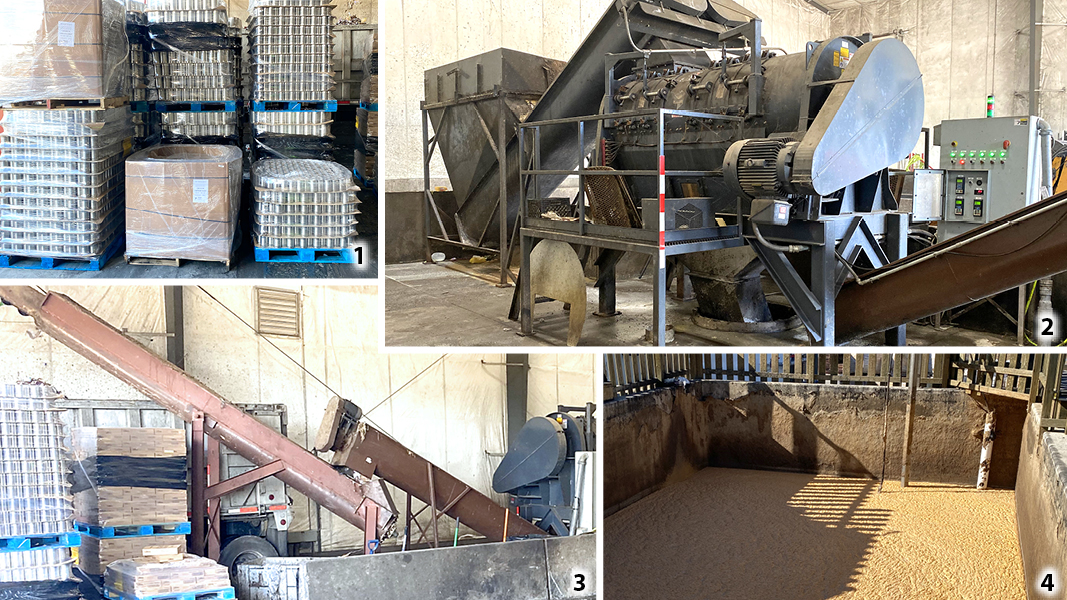
Off-spec or out-of-date packaged food (1) is loaded into the hopper of the Scott Equipment Turbo Separator (2). Packaging is conveyed to a trailer (3). Slurry exits the bottom of the separator and is pumped into the 50,000 gallon food waste tank (4).
A few months after the Turbo Separator was installed, Reinford reached out to PADEP about bringing slurried food waste from its farm to other digesters. Staff from PADEP visited the farm to learn more about the depackager — and ended up deciding to impose restrictions on its operation, primarily to address contamination that may end up in the slurried food waste. The actual amount of contamination is miniscule compared to the total quantity of food waste run through the Turbo Separator. “Whether you look at it by weight or volume. I estimate it is 1/1000th of one percent based on a calculation I did,” notes Reinford. “One percent of the 12,000 tons of food waste we recycle in a year would equal 240 lbs of contaminates. In the 10 years we been recycling food waste, which is nearly 80,000 tons since we started, we haven’t come close to 240 lbs worth of contamination.”
Despite this miniscule amount, tiny specks of plastic are visible in the farm fields. “That is the reason for DEP’s concern — and us quite frankly,” he adds. “We learned a lot since we first started depackaging food waste and our contamination level is even less now. The challenge is PADEP does not have a specific permit for depackagers, thus there is no clear guidance on what is required for compliance. I reached out 2.5 years ago and this still has not been resolved.”
Since the beginning of 2020, PADEP has imposed limits on the amount of packaged food waste the farm can process. “The Department wants 0% contamination, and that is not possible,” says Reinford, adding that it is #5 polypropylene, such as what is used in yogurt containers, that creates issues because it can shatter during depackaging. “The Department is uncertain how to permit this type of operation and what a contaminant limit should be. Right now, it keeps asking us to use smaller and smaller screens, but that is not realistic. And the state’s General Permit for anaerobic digestion of food waste has no language in it about contamination.”
Energy And Nutrient Recovery
The two digesters produce about 288,000 cu.ft./day of biogas. The farm acquired a new 499 kW MAN combined heat and power engine as its old 140 kW CAT engine was undersized (but is still operating). Power is sold to PPL Utilities for $0.06/kW, which is about half of what the utility used to pay Reinford Farms. “We are disappointed at the $0.06/kW and explored other outlets for selling the renewable energy,” notes Reinford. “We spoke with brokers, but the price per kilowatt is even lower than what we currently receive.”
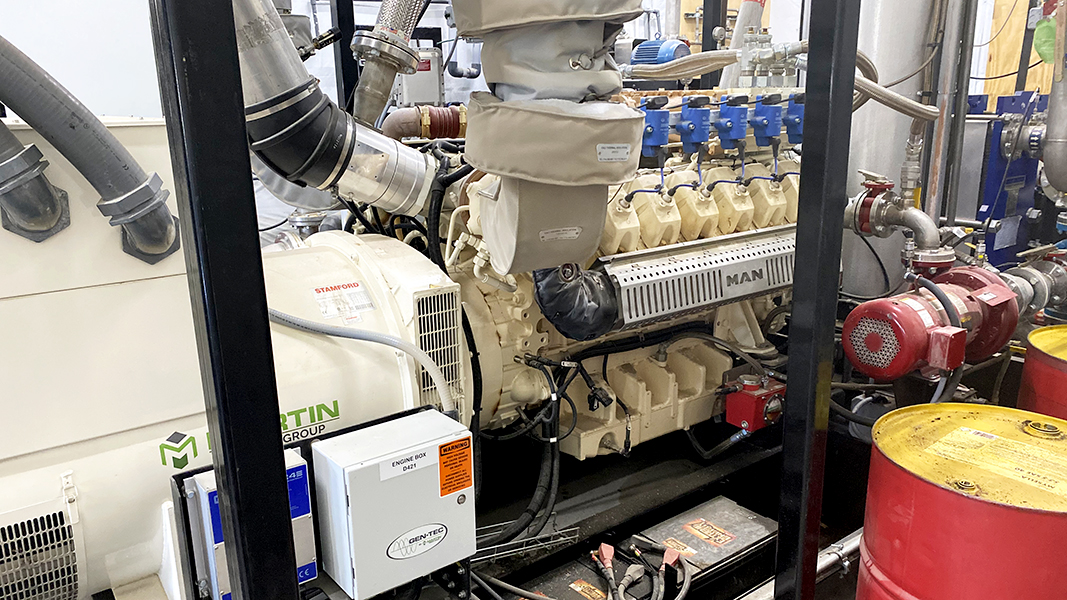
Combined, the 2 digesters produce 288,000 cu.ft./day of biogas. The farm has a new 499 kW MAN combined heat and power engine (above).
He would like to see the U.S. EPA activate the “e-RIN” pathway in the federal Renewable Fuel Standard (RFS). E-RINs are credits created by utilizing electricity generated from biogas to charge electric vehicles (versus, for example, electricity generated by coal or natural gas plants). Electricity produced with biogas from manure and other organic materials at dairy, swine and other farms qualifies as a renewable fuel under the RFS, just as renewable natural gas (RNG) does. “Electric RINs would easily double what we currently receive for our power,” says Reinford. “We’ve been to Washington, D.C. to lobby for activating this pathway, but to date, EPA has been unwilling.”
Reinford Farms is exploring the option of producing RNG, but the closest natural gas pipeline, where it could inject the RNG, is 15 miles from the farm. “It doesn’t make sense to pipe it,” he notes. “If we could use it on the farm, for example as fuel for our truck fleet, that could be cost-effective.”
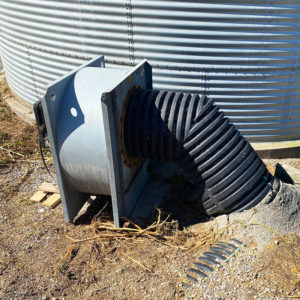
Heat recovered from the engines is used to dry harvested corn for feed as well as to heat farm buildings.
The farm uses heat recovered from its engines to dry harvested corn for feed. The heat also is used in the milking barn to provide hot water and other buildings on the farm. Savings on not having to purchase fuel oil, combined with a small amount of revenue generated from sale of its Renewable Energy Certificates to its dairy co-op, are additional benefits realized from the digester operations.
Digested solids are used as bedding for the cows; the liquids are land applied on 1,400 acres that the Reinfords own or rent. While it has adequate acreage at the moment to comply with its nutrient management plan, Reinford foresees a time when it will have to explore nutrient recovery options. “Land is getting harder to come by,” he says. “We’ve been looking at various processes to take out more nutrients so that we can spread the digested effluent over a greater distance.”
Over the years of reporting on Reinford Farms in BioCycle, a recurring theme has been the family’s willingness to embrace innovation and advance the art and science of codigestion of food waste on dairy farms. A second recurring theme is their willingness to share what they’ve learned and are learning — real-time, hands-on knowledge from which everyone benefits.


